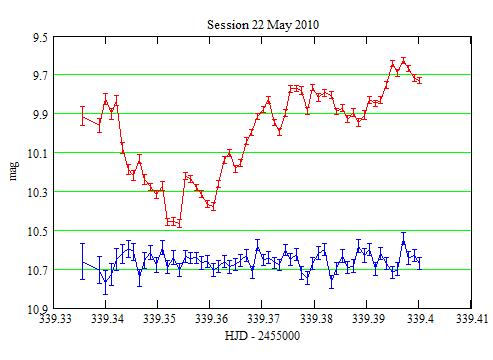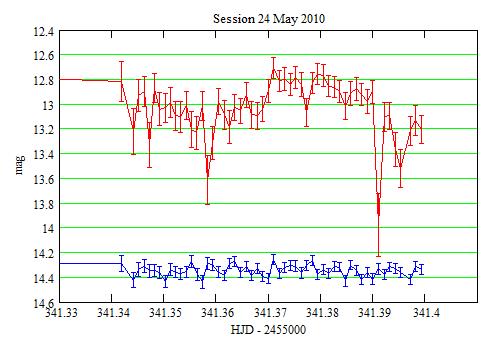EX Hya outburst
Observed: 22, 24 May 2010
Michel Bonnardeau
23 May 2010
Updated 25 May 2010, 13 Feb 2011
Abstract
A light curve of this cataclysmic system in outburst is reported.
Introduction
EX Hya is a cataclysmic star, that is a binary system with an accreting white dwarf. The orbital period is 1.63 hour. The white dwarf is magnetic and this modulates the accretion with the spin period 1.12 hour (almost equal to the orbital period). (Warner (1995) p 370). The system also has outbursts. It is classified as both an Intermediate Polar and a Nova Like.
On May 22, 2010 it was observed by R. Stubbings as in outburst (AAVSO Special Notice 211). Such outbursts happen every 1.5yr with a very irregular interval between (Hellier et al (2000)).
Observations
The observations were carried out with a 203 mm f/6.3 SC telescope, a Rc filter and a SBIG ST7-E camera (KAF401E CCD). 59+54=113 images were obtained, each with an exposure duration of 60 seconds. From my location, the airmass is greater than 3.
The comparison star is GSC 6709-0321 (AAVSO 000-BBT-327) with a Rc magnitude of 10.886, computed from the CMC14 r' magnitude, the 2MASS J, H, Ks magnitudes and using the transformation formulas of Bilir et al (2007). The check star is GSC 6709-0006 (AAVSO 000-BBT-331).
The observed light curves:

Red: EX Hya, Blue: the check star shifted by -1.2mag. The error bars
are +/- 1-sigma statistical uncertainties.
The average statistical uncertainty of the check star is 0.036mag,
and the standard deviation is 0.047mag.
The atmospheric extinction is k'=0.337mag/airmass. The differential extinction
between EX Hya and the comparison star is at most 3mmag.

The check star is shifted by +2.5mag. Its average statistical uncertainty
is 0.044mag and the standard deviation is 0.046mag.
The atmospheric extinction is k'=0.009mag/airmass. The moon is at 16° only.
Reference
Bilir S., Ak S., Karaali S. et al (2007) MNRAS arXiv/astro-ph: 0711.4356v1.
Hellier C., Kemp J., Naylor T. et al (2000) MNRAS 313 703.
Warner B. (1995) Cataclysmic variable stars Cambridge U.P.
Astronomical notes
I observed this object in 2004.
Technical notes
Telescope and camera configuration.
Computer and software configuration.
|
|
|||
|
|||
|
|
|||
|
|
|||
|
|||
